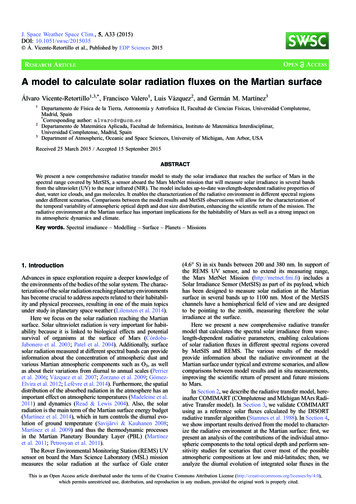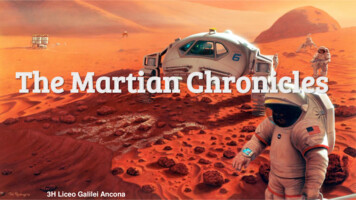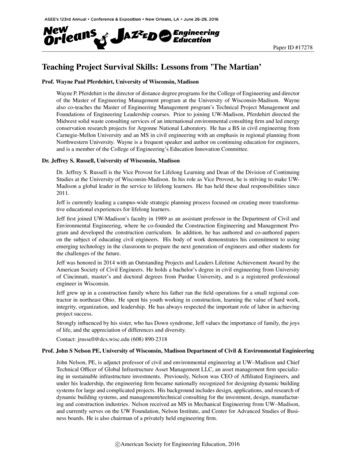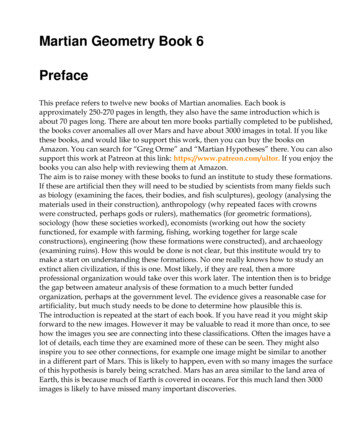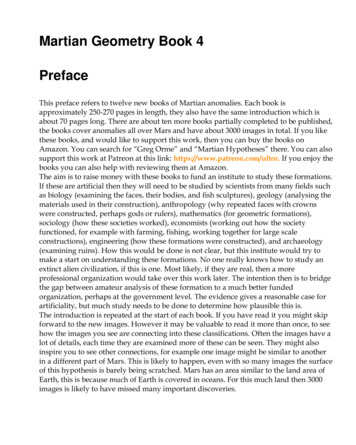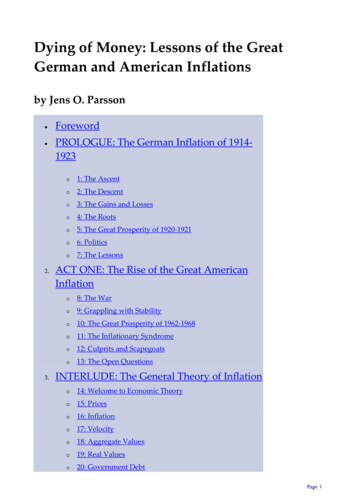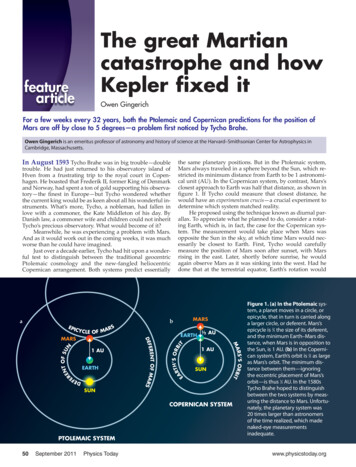
Transcription
The great Martiancatastrophe and howKepler fixed itfeatureOwen GingerichFor a few weeks every 32 years, both the Ptolemaic and Copernican predictions for the position ofMars are off by close to 5 degrees—a problem first noticed by Tycho Brahe.Owen Gingerich is an emeritus professor of astronomy and history of science at the Harvard–Smithsonian Center for Astrophysics inCambridge, Massachusetts.In August 1593 Tycho Brahe was in big trouble—doubletrouble. He had just returned to his observatory island ofHven from a frustrating trip to the royal court in Copenhagen. He boasted that Frederik II, former King of Denmarkand Norway, had spent a ton of gold supporting his observatory—the finest in Europe—but Tycho wondered whetherthe current king would be as keen about all his wonderful instruments. What’s more, Tycho, a nobleman, had fallen inlove with a commoner, the Kate Middleton of his day. ByDanish law, a commoner wife and children could not inheritTycho’s precious observatory. What would become of it?Meanwhile, he was experiencing a problem with Mars.And as it would work out in the coming weeks, it was muchworse than he could have imagined.Just over a decade earlier, Tycho had hit upon a wonderful test to distinguish between the traditional geocentricPtolemaic cosmology and the new-fangled heliocentricCopernican arrangement. Both systems predict essentiallyTH’S ORBIARNOF SUNTRET½ AU1 AUSUNDEFESUNCOPERNICAN SYSTEMPTOLEMAIC SYSTEM50September 2011Physics TodayRS’S ORBITEARTHEARTHMA1 AUMARSbERENT OF MARSDEFEPISCYCLE OF MARMARSEathe same planetary positions. But in the Ptolemaic system,Mars always traveled in a sphere beyond the Sun, which restricted its minimum distance from Earth to be 1 astronomical unit (AU). In the Copernican system, by contrast, Mars’sclosest approach to Earth was half that distance, as shown infigure 1. If Tycho could measure that closest distance, hewould have an experimentum crucis—a crucial experiment todetermine which system matched reality.He proposed using the technique known as diurnal parallax. To appreciate what he planned to do, consider a rotating Earth, which is, in fact, the case for the Copernican system. The measurement would take place when Mars wasopposite the Sun in the sky, at which time Mars would necessarily be closest to Earth. First, Tycho would carefullymeasure the position of Mars soon after sunset, with Marsrising in the east. Later, shortly before sunrise, he wouldagain observe Mars as it was sinking into the west. Had hedone that at the terrestrial equator, Earth’s rotation wouldFigure 1. (a) In the Ptolemaic system, a planet moves in a circle, orepicycle, that in turn is carried alonga larger circle, or deferent. Mars’sepicycle is 2 3 the size of its deferent,and the minimum Earth–Mars distance, when Mars is in opposition tothe Sun, is 1 AU. (b) In the Copernican system, Earth’s orbit is 2 3 as largeas Mars’s orbit. The minimum distance between them—ignoringthe eccentric placement of Mars’sorbit—is thus 1 2 AU. In the 1580sTycho Brahe hoped to distinguishbetween the two systems by measuring the distance to Mars. Unfortunately, the planetary system was20 times larger than astronomersof the time realized, which madenaked-eye measurementsinadequate.www.physicstoday.org
SightingarmsDEVIATION FROMPREDICTION (degrees)3210 1 2 3 4 5158015851590YEAR15951600Figure 3. Errors in the predicted celestial longitudes of Marsderived from the Copernican-based Prutenic Tables. The errorsclosely repeat after 32 years. The large Martian catastropheerror of nearly 5 took place in 1593 and was repeated in 1625.Figure 2. The equatorial armillary, Tycho’s most impressive instrument, completed in 1585. The tilted axis running throughthe large (2.7-m wide) circle is parallel with Earth’s axis. The circle is calibrated with 90 at the poles and 0 at the midpoint ofits circumference. Two sighting arms establish the declination,the angular distance (north or south) of a star from the equator.Tycho could use one sighting arm to read the declination of astar or planet and then, in less than a minute’s time, rotate thecircle 180 about the tilted axis to make a second independentdetermination with the other arm. (Published in 1662 andbased on Tycho’s original version, this illustration is by WillemBlaeu, a former assistant at Tycho’s Hven observatory.)have provided a triangulation baseline equal to Earth’s diameter. At his more northern latitude, the baseline was somewhat shorter, but still long enough for his purpose.Today we know that the determination is impossiblewith naked-eye observations. But in the 16th century, all astronomers accepted an erroneous value for Earth’s distanceto the Sun—a value 20 times too small. Had the small valuebeen correct, Tycho’s amazingly precise observations wouldhave yielded the result he was looking for. But unknowingly,he was foiled.Making refraction tablesMartian oppositions come, on average, two years and sevenweeks apart. Tycho tried to find the distance to Mars in December 1582 without success; his instruments were not yetgood enough. Armed with an improved observatory andwww.physicstoday.orgmore stable devices, he tried again in late January 1585. Butto his surprise (and annoyance) he got a negative parallax,which implied that Mars was more than infinitely far away.He knew that was absurd and soon suspected the root of theproblem—what we now call differential refraction. NormallyTycho made his observations of objects high in the sky, butthe diurnal parallax procedure required observing Marswhen it was near the horizon, where atmospheric refractionlifts a planet or star slightly higher above the horizon. Because the comparison stars were at different altitudes thanMars, it was necessary to correct their apparent positions.1So Tycho set out to establish a refraction table—two ofthem, in fact. Determining observationally the amount of atmospheric refraction at a given altitude requires knowing thetrue, or unrefracted, altitude for comparison. Tycho had twoways of deducing that unrefracted altitude—one using theSun, the other using the stars. In the first case, he establisheda theory of the Sun’s movement intended to give true solarpositions, and he observed the midday apparent altitudes ofthe Sun using his large mural quadrant firmly affixed to aninside wall of his castle. But in deriving his theory for the truesolar positions, he used the assumed but incorrect distanceto the Sun, which led to a slightly erroneous eccentricity forthe solar orbit. That, in turn, led unwittingly to a flawed refraction table.For stars, Tycho used his new large equatorial armillary,shown in figure 2, the most impressive instrument in his observational armory. With the instrument, he directly measured the apparent declination of a star—its angular distanceabove the equator—at the same time that another instrumentyielded the star’s observed altitude, its angular distanceabove the horizon. Atmospheric refraction affected the declination measurement, which otherwise would have beenconstant. And from the varying declinations, measured as astar ascended or descended in altitude, another refractiontable could be deduced.In March 1587, with Mars again opposite the Sun in thesky, Tycho undertook another observational campaign. Butwhich refraction table should he use? After applying the solartable, oblivious to its errors, he promptly found a parallaxthat matched the Copernican case—little realizing that thederived parallax was an artifact of the errors in the solar refraction table. Almost immediately he wrote to several correspondents that he had succeeded in establishing the comparatively close approach of Mars.Ironically, however, Tycho did not adopt the Copernicancosmology. Although the Copernican cosmology nowhereSeptember 2011Physics Today51
TBIRTHEAOFOCTbMperiKEPLE ’ICUNERCOPAPROMapFigure 4. (a) In Nicolaus Copernicus’s system, Earth (green) moves uniformly around a point Q (called an equant), the center ofits eccentric orbit, from aphelion Eap to perihelion Eperi and back. Because the observed quadrant from January to April has a shorterpart of the circumference than the quadrant from April to July, the Sun appears to move more quickly during the Northern Hemisphere’s winter than during its summer; hence winter is shorter than summer. But because Johannes Kepler believed that Earthshould actually move faster when it is nearer the Sun, he bisected the eccentricity and thereby shifted Earth to a less eccentricorbit (red). In Kepler’s system, half the Sun’s apparent nonuniform motion is caused by the eccentric position of the Sun, and half iscaused by the actual nonuniform motion of Earth. (b) The orbits of Mars (M, red) and Earth (E, green) are shown to scale, with Marsat its perihelion making its closest approach to Earth at the time of the great Martian catastrophe. When Kepler bisected the eccentricity of Earth’s orbit, the orbit’s center slipped along the apsidal line away from the direction of its aphelion. That repositionedEarth just enough to eliminate the major errors in the observed longitude of Mars. In both diagrams the eccentricity of Earth’s orbitis greatly exaggerated for clarity.offended the principles of mathematics, he argued, Earth, asa lazy, sluggish body, was unfit for motion. So he opted instead for a geoheliocentric alternative. In that so-called Tychonic system, Earth stands immobile in the center of the universe, while Mars circles the Sun as the Sun in turn circlesEarth. In both Tychonic and Copernican systems, Mars cametwice as close as in the Ptolemaic system.Tycho was, however, a brilliant scientist unwilling to letthe rather arbitrary choice of refraction table go unexamined.Using his equatorial armillary, he proceeded to derive a newrefraction table for the planet Jupiter. He discovered his errorand lapsed into silence concerning his measurement of thedistance of Mars from Earth.The march of the Martian oppositions around the calendar brought the next event into the short nights of summer;June 1591 was unsuitable for a fresh campaign. But in August1593 Tycho was ready to try again. However, after his returnfrom Copenhagen, the weather was rotten. Rain, wind, andthunder storms were recorded in his meteorological diary.At last the skies cleared, and on 13 August he brieflyresumed his examination of Mars. He tabulated the results inhis log book:Tycho Brahe’s observed errorsLongitudeDifferenceCopernican tables342 0′ 4 71 2′Tycho’s observation346 71 2′Alfonsine [Ptolemaic] tables351 26′52September 2011Physics Today 5 181 2′They were a catastrophic shock. The ruddy planet wasnowhere near its predicted place using either cosmology. Thevalues were off by 4 or 5 degrees, in opposite directions, andremained so for several weeks (see figure 3).Enter KeplerBy November 1600 Tycho had solved the inheritance problem. He left Denmark for the court of Rudolf II, the HolyRoman emperor, and brought his family and his instruments.In Prague the laws were different. There his wife and childrencould inherit his wealth.2About a year after his arrival, Tycho added a young assistant to his staff: Johannes Kepler, a Lutheran high schoolteacher who suddenly found himself underemployed whenthe Catholic Counter Reformation swept into southern Austria. In Tycho’s employ, Kepler was assigned the recalcitrantproblem of Mars. Did Tycho tell Kepler about the Martian catastrophe in 1593? Probably, but no one really knows. In anyevent, he would have found it in Tycho’s log book.Kepler soon discovered that the problem wasn’t withMars at all, but arose entirely with the orbit assigned to Earth.Contrary to today’s widespread but uninformed opinion, thesystem proposed by Nicolaus Copernicus held that planetsdid not revolve in circular orbits centered on the Sun. Rather,they moved in eccentrically placed orbits—faster when closerto the Sun. Earth was the sole exception; it was thought tohave an eccentric orbit and yet move at constant speed. Andthat, Kepler thought, had to be wrong.In the ancient, geocentric universe, the entire heavenscontinually whirled about Earth, one rotation per day. Thestars moved the fastest, and the planets slightly slower, downwww.physicstoday.org
Michael Maestlin, urged him to forgetabout physical causes and to attend togeometry alone for explanation. But in(H)Kepler’s vision, Earth’s constant speed in(Θ)the Copernican system made no physicalsense. Surely it should actually move(E)faster in January when it was closer to theSun. In both Ptolemaic and Copernicansystems, the Sun appeared to move fasterin January because of the eccentric positioning of its, or Earth’s, orbital circle. Kepler called the phenomenon the optical ef(K)fect. But he also wanted the total apparentmotion to be a combination of the opticaleffect and a physical effect. If each effect(Z)played a comparable role, then the Copernican eccentricity of Earth’s orbit had to behalved, or bisected, Kepler reasoned. Inthat case, the Sun’s varying distance fromEarth would be half as great as previouslyassumed, as shown in figure 4a.Figure 5. Johannes Kepler’s triangulation diagram, adapted from his 1609How could Kepler measure that subAstronomia nova, established the position of Earth’s orbit. In the Copernicantle difference between the Earth–Sun dissystem, Mars returns to the same position K on its orbit every 687 days. Earth,tance in January and in July? One way wasstarting at Θ, makes a complete counterclockwise revolution every 365 days andto measure the apparent diameter of thecontinues around to H after the remaining 322 days it takes Mars to complete itsSun through the seasons. Kepler devisedan instrument to do just that, but the rerevolution. Similar times bring Earth to E and Z in subsequent revolutions of Mars.sults were not as convincing as he hadKepler thus verified that Earth’s orbit needed to be shifted from the solid outlinehoped. A half century later, the asto the dashed one. (Adapted from J. Kepler, Astronomia nova, 1609, p. 131.)tronomer Giovanni Domenico Cassiniused a meridian projection in the Bolognato the Moon, which lagged behind the rest. The source of the cathedral in Italy to persuasively confirm the effect and esrotation, according to Aristotle, was the goodness of God, who tablish his own brilliant reputation.4Meanwhile, Kepler turned to the very precise observasupplied the motion from beyond the starry firmament.In the Copernican system, by contrast, the stars provided tions that Tycho had made in his campaign to measure thea fixed outer framework. Hence the driving power for the distance to Mars. A famous diagram in Kepler’s 1609 Astronoplanetary system had to come from the inside—from the Sun mia nova, reproduced in figure 5, shows his ingenious trianitself. And that made sense to Copernicus, who had noticed gulation procedure. Mars has an orbital period of 687 days,that the closer a planet was to the Sun, the faster it moved. but each time Mars returned to a given position in its orbit,Indeed, that aesthetic arrangement was a primary reason Earth would have fallen 43 days short of making two comwhy the Polish pioneer had opted for a heliocentric universe. plete revolutions. Terrestrial observers would therefore beAs Copernicus wrote in his De revolutionibus orbium viewing Mars at that position from two different vantagecoelestium, “In no other way do we find a sure bond of har- points. By collecting from Tycho’s log books observationsmony between the movement and magnitude of the orbital 687 days apart, Kepler’s triangulation system precisely pinpointed Earth’s orbital trajectory. As he suspected, the eccencircles.”3But why, in Copernicus’s arrangement, was Earth unique tricity of Earth’s orbit in the Copernican system needed to bein orbiting at constant speed? That was simply an artifact bisected.Whether Kepler completely realized that this movefrom his transformation of Ptolemy’s epicyclic geocentricgeometry into a heliocentric one. In the Copernican system, solved the Martian catastrophe is not clear. But he nextto a rough approximation, the observed position of a planet turned to a more subtle problem. In tracking the heliocentricis determined by the combination of two circles—the helio- positions of Mars, Kepler found that the use of a circular orbitcentric orbit of Earth and the heliocentric orbit of the planet. led to an 8’ error at the octants of its orbit. Because God hadLikewise, in the Ptolemaic system, the position of a planet is given him such a great observer in Tycho Brahe—whose typroughly determined by two circles—the deferent, or carrying ical observational errors were 2’ or less—Kepler wrote thatcircle, and the epicycle. For the superior planets—Mars, he dared not stop with a maximum error of 8’. (When MarsJupiter, and Saturn—the epicycle played the role of Earth’s was observed from Earth at close approach, the heliocentricorbital motion in the Copernican system; and for simplicity error of 8’ became nearly a half-degree geocentric error.) ThusPtolemy assumed uniform circular motion in the epicycle, an Kepler continued waging war on Mars, eventually coming upassumption that turned out to be a generally acceptable ap- with the elliptical orbit, which reduced the errors by an orderproximation. So when Copernicus made the transformation, of magnitude.In fact, Kepler tried a variety of oval curves that couldEarth’s orbit, like the Ptolemaic epicycles, carried the planethave fit the observations equally as well as the ellipse. But hein uniform circular motion.was unsatisfied with the physical basis for choosing any ofPhysics and geometrythem until he noticed that one focus of an approximating elIn Kepler’s day, virtually all astronomers looked to mother lipse coincided with the Sun. That curve and focus made itgeometry for inspiration. Kepler was unique in seeking phys- easier for Kepler to conjure up a physical explanation. (Focus,ical causes for celestial motions. Even his astute teacher, the Latin word for “hearth,” was coined by Kepler to have itswww.physicstoday.orgSeptember 2011Physics Today53
current geometric sense, for the Sun is the hearth of the universe.) Kepler’s erstwhile sparring partner, David Fabricius,wrote that he could equally well match the observations witha set of circles. Kepler responded petulantly, “You say adaughter was born to you of mother geometry. I saw her; sheis beautiful. But she will be a most mischievous whore, whowill seduce the husbands away from my many daughtersborn of mother physics.”5Kepler refused to include Fabricius’s model in his Astronomia nova, and he broke off the long-running correspondence with Fabricius. For Kepler, a physical model was paramount in a satisfactory explanation. He subtitled his bookAitiologitos, seu physica coelestis (“Based on causes, or the celestial physics”). His wrestling with Mars was finished, buthis path-breaking book would not be published for anotherfour years, delayed by skirmishes with Tycho’s heirs, whofeared that Kepler would take all the juice out of Tycho’s observations and reduce the value of the single greatest treasurein their inheritance.Linz, August 1625Thirty-two years after Tycho had recorded the great Martiancatastrophe, the conditions were right for a repeat performance, and once again, in 1625, the Ptolemaic and Copernican tables showed a huge discrepancy. Because Mars wasnear the perihelion of its orbit—its closest approach to theSun—the ellipticity of its orbit had nothing to do with theerror in its longitude as observed from Earth. The entire errorarose because Earth’s orbit had been positioned wrong (seefigure 4b). At that time Kepler was working on his greatRudolphine Tables, published in 1627, for predicting the positions of all the planets. With a correctly repositioned Earth,the error in Mars’s predicted position disappeared. Keplernow knew that he had fixed the great Martian catastrophe.Kepler’s correction had reduced the maximum errors inthe predicted positions for Mars by an order of magnitude,from nearly 5 to about 0.5 . That half-degree error came notwhen Mars was at perihelion but when Earth made a closeapproach to Mars at an octant position in its orbit. Later,after placing Earth in an elliptical orbit, Kepler reduced themaximum errors by another order of magnitude—fromabout 30’ to 2’.Kepler died in 1630, before Galileo published his Discourses and Mathematical Demonstrations Relating to Two NewSciences (1638) with its premonition of the law of inertia.Without the concept of inertia, Kepler’s physics was fatallyflawed. Nevertheless, his intuition about the importance ofphysical causes was correct. Isaac Newton, in a 1686 letter toEdmond Halley about planetary orbits, perceptively remarked that “Kepler knew the orb to be not circular but oval& guest it to be elliptical.”6 Yet Newton was selling Keplershort, because in his insistence on an astronomy based on celestial physics, Kepler was truly paving the way for Newtonhimself.References1. O. Gingerich, J. Voelkel, J. Hist. Astron. 29, 1 (1998).2. V. E. Thoren, The Lord of Uraniborg: A Biography of Tycho Brahe,Cambridge U. Press, New York (1990).3. N. Copernicus, De revolutionibus orbium coelestium (1543), bk I,chap. 10.4. J. Heilbron, The Sun in the Church: Cathedrals as Solar Observatories,Harvard U. Press, Cambridge, MA (1999).5. J. R. Voelkel, The Composition of Kepler’s Astronomia nova, Princeton U. Press, Princeton, NJ (2001), p. 210.6. I. Newton to E. Halley (20 June 1686), in The Correspondence ofIsaac Newton, vol. 2, H. W. Turnbull, ed., Cambridge U. Press,New York (1960), no. 288. OSA’S 95TH ANNUAL MEETINGFRONTIERS IN OPTICS 2011LASER SCIENCE XXVIIAPS/DLS 27TH ANNUAL MEETINGTECHNICAL CONFERENCE: 16–20 October 2011EXHIBIT: 18–19 October 2011Fairmont Hotel/Sainte Claire HotelSan Jose, California, USALEARN. NE T WORK. EXPLORE.Benefit from valuable networking opportunitiesand a dynamic technical program covering a widearray of topics. More than 200 invited speakers and over500 contributed talks 5 Special SymposiaIMPORTANTIMPORTA NT DEDEADLINEAD LINE DATESDATTE SPre -Registration Deadline:Pre-Registration27 SeptemberSeptember 2011Save up to 100 USD when youregister early. Plenar y and Awards ProgramHousing Deadline:Housing16 SeptemberSeptember 2011 8 Shor t Courses, 2 new courses this yearBook with Travel Planners, the officialhousing partner, for special benefits. FiO Expo and a wide array of networking events Student and Yooung Professional ActivitiesPPostdeadlineostdeadline PPaperaper Deadline:3 OctoberOctober 2011Submit your late breaking research.REGISTER NOW!For more conference programinformation and to registerr, s.orgUse your Smartphone to scanthis QR Code for moreinformation on FiO/LS 2011FrontiersFrontiers in OOpticsptics 2011 ChairsChairsLahsen Assoufid, Argonne NationalLab., USA, Generrala ChairThomas Carruthers, National ScienceFoundation,oUSA, General ChairInuk Kang, Bell Labss, Alcatel-Lucent,USA, Program ChairDavid Reitze, Univv. of Florida,lUSA,Program ChairLaserLaser ScienceScience XXVIIXXVII CChairshairsRobert Boyd, Univv. of Rochesterr, USA,General ChairRoseanne Sension, Univv. of Michigan,USA, General ChairSPONSORED BY:
The great Martian catastrophe and how Kepler fixed it Owen Gingerich For a few weeks every 32 years, both the Ptolemaic and Copernican predictions for the position of Mars are off by c
